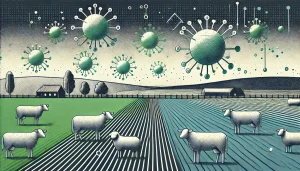Zoonoses: How Human and Animal Infections are Inte...
How the human immunodeficiency virus (HIV) emerged, how to protect against zoonotic diseases, and why vaccinat...
How has green fluorescent protein (GFP) propelled organic chemists? What is a ‘brainbow’? What can be achieved by labelling and mapping the central nervous system? These and other questions are answered by professor Jeff Lichtman.
Neuroscience as a field got its start with the Golgi stain, and this was the stain that Camillo Golgi developed in his kitchen and labelled a small subset of cells that allowed you to see them in their full glory. And you could see them in their full glory, because it was only labelling a very, very small subset of cells that were randomly distributed amongst many other cells that were not labelled. This was a breakthrough and it revolutionized, in the late eighteen hundreds, our view of how the brain was organized.
But it’s not enough, it was insufficient. And over the years people have been thinking about ways of getting more information. You can inject cells with dyes. Again, you see a small subset, you can stain tissue to find molecular markers that show you which sells a of a particular type, but if you’re interested in circuits, what basically you have to do is see every cell that’s connected – each as an individual entity, each is an entity that’s separate from every other one. Many of the cells that are separate from each other are not molecularly very different – they just happened to wire differently, based on experience.
So the green fluorescent protein is a protein, we shine blue light on and it gives off green light. And shortly after green fluorescent protein was discovered, organic chemists began understanding why it was fluorescent and realize that they could mutate the green fluorescent protein to make a red version or a yellow version, which would fluoresce different colors. Several groups in Russia, for example, discovered that there were a whole range of marine animals that like corals had fluorescent pigments in them that were very similar to green fluorescent protein, but different colors and those gene products could also be put into animals.
So now we have a wide range of colors that can be put into animals, but certainly not enough colors to make every cell in the brain a different color. There’s not enough colors, but there is this interesting fact that we, humans, see all the colors that we see with only three kinds of photoreceptors in our own eye. We are only sensitive to red, to green and to blue, and it’s the combination of how much red, green and blue signal there is in each little part of the visual scene that gives each part its own unique colour. So we thought: well, if we could put a random amount of red, green and blue fluorescent protein in each cell, each cell would be some colour in the spectrum of the rainbow and we’d be able to see lots of them.
So that’s what we did. Jean Livet was a postdoc when he began this working, now he has his own lab in Paris, and Josh Sanes is a colleague of mine here and I, with the help of several other really smart young people, built a tool that made mice that generated lots of colors in each nerve cell. And it’s a form of recombination, when you take a genetic insert and you randomly cause a subset of the colors that could be expressed to actually be expressed, so each cell ends up with a rather different color spectrum than each other cell. This is the brainbow approach.
We have gone on to make brainbow viruses, so that you can inject any animal and infect their brain with these colors, basically to get each cell a different color.
So this is a tool that is good for tracing; it’s extremely good in the peripheral nervous system, for example, the motor neurons that go to muscle fibres, where there’s not much else out there.
This is great, you can trace wires very long distances, you can map virtually everything in the wiring diagram.
When you use tools like brainbow in the central nervous system and you label everything, you’re immediately discouraged by the massive amount of things that are there. They’re so dense, that a light microscope often has trouble disambiguating the wires, even though you have lots of colors. So we have been trying to think of other ways of kind of getting beyond the technical difficulties, and one is, rather than trying to look through a volume of brain, let’s slice the brain really thin, and for us really thin is about thirty nanometers. A nanometer is really small, it’s 10 angstroms, 10 hydrogen atoms thick. So 30 nm is about one thousandth as thick as a human hair. That’s how thick our brain sections are, they are very thin and we made an automatic tool. Ken Hayworth and Richard Schalek built this tool that cuts brains at that thinness and then picks them up on a conveyor belt of tape, so we end up with this long tape, where each section of the brain is 30 nanometers, in front of the section before, down this gigantic tape. So you take a volume of a brain and you linearise it onto what looks like a piece of movie film, and we take a picture of each of those frames. And if you play through that movie, it’s like playing through not a time lapse but the space lapse – you start in the front of the brain and you go back and you can follow every little wire, every little direction.
We are using that tool mainly with electron microscopy now to trace out virtually every wire, we call it a saturated connectomic reconstruction, where we do connectomics. But we label every single wire and get every single connection, and it’s dense data, it’s about two terabytes per cubic millimetre. So it’s a lot of data and we are running out of storage all the time, and analysis is a tremendous problem, but we are making great progress, because we started at nowhere.
The fundamental problem, the one that still keeps me up every night is how to analyse this data. We have been analysing a little piece of mouse brain, that is one billionth the size of the whole mouse brain, for the past four years. That’s all we have been doing – analyzing this one teeny-weeny piece, and it’s just extraordinary, how much you can analyze in something so small. To imagine doing this over a larger scale is still very hard. I have a feeling this is a field that’s sort of like other fields in biology, it’s going to be taken over by a more talented people: mathematicians, physicists, engineers, computer scientists, and that we will generate the data, but then they will analyse it, because we are amateurs at analysis. We know what is interesting to analyze, but we are not really good at building the tools for analysis. I think this is a maturation of our field that has not yet really happened, but it is just beginning now.
One big question of this field of connectomics and of making tools like this is: what do they hold for us in our future?
I would say, one extreme view, and maybe an exciting one, is that if you had complete wiring diagrams of the brain, if these tools really gave you that, you could then put those wiring diagrams into something like silicon, you could make a virtual brain that is inspired, not just at a distant way, but synapse by synapse inspired by a physical real brain, and therefore you might have intelligence that is like biological intelligence now instantiated in computers. So that’s one interesting idea.
Another one that may sound like science fiction, but it is also very provocative idea, at the moment it is still science fiction, is that once you have a wiring diagram like this, you can send this wiring diagram out into space at the speed of light. And so, if an intelligent community somewhere, very far away, wanted to get a sense of what we are like instead of sending our bodies, you could send our minds.

How the human immunodeficiency virus (HIV) emerged, how to protect against zoonotic diseases, and why vaccinat...

Scientists used 3D-printing technology to investigate the possible reasons why seahorse's tail evolved into it...

Neuroscientist Diana Omigie on empathy, different approaches to emotions, and research in music psychology